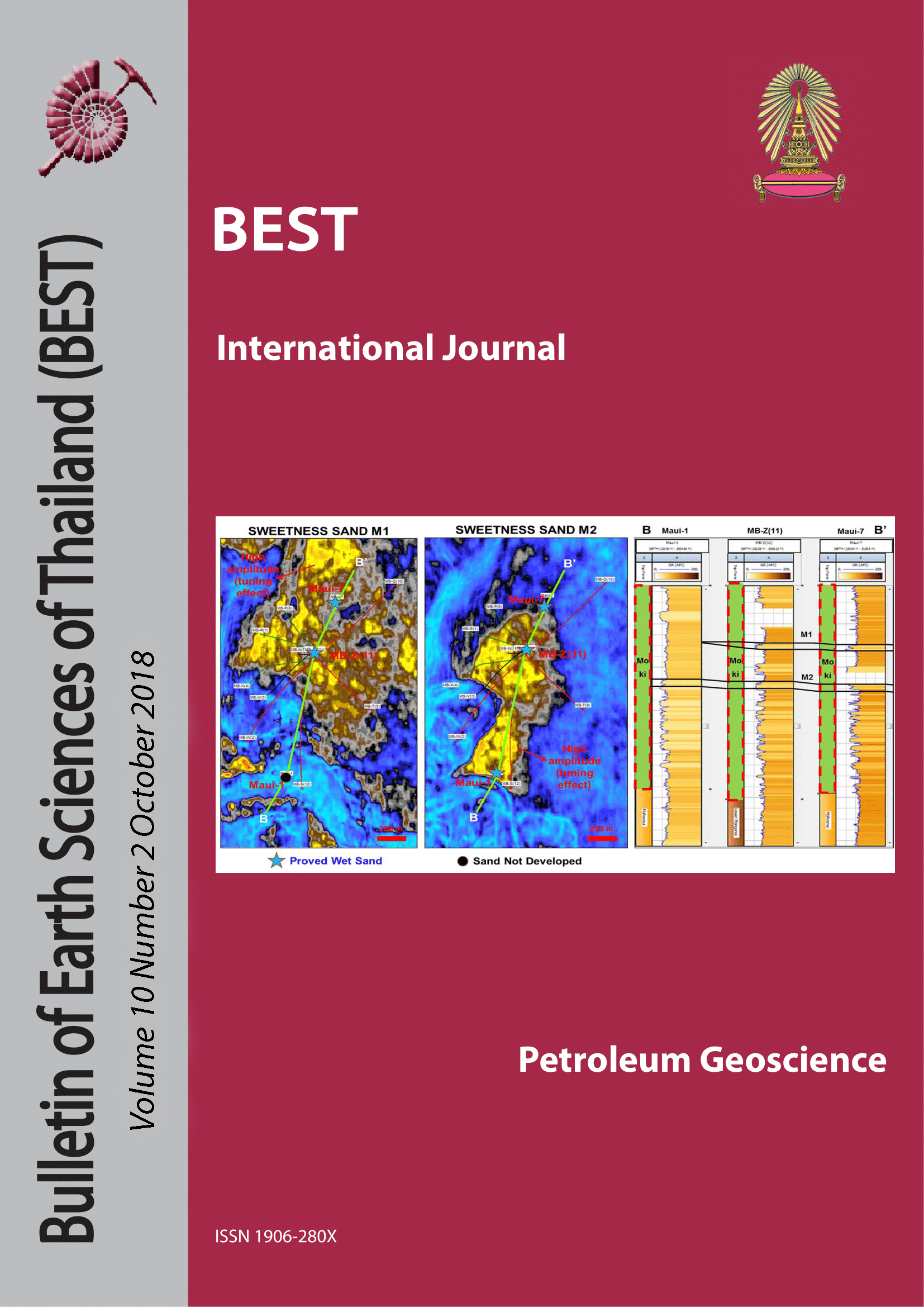Diagenesis and Depositional Control in LKU (K, L and M) Formation: A Study to Support Waterflood Activities in Sirikit Oil Field, Thailand.
Main Article Content
Abstract
This study focuses on the eastern part of central fault block of the Sirikit Oil Field in the Phitsanulok basin, onshore Thailand. Since 2008 the field has produced mainly crude oil from the early Miocene LKU-K, LKU-L and LKUM reservoirs which are all deposited in a fluvio-deltaic lacustrine setting. As oil production was starting to decrease, water flood activities were implemented in 2014. However, the results of the water flood revealed that the production performance by water flooding was below expectations. Hence, a number of studies have been undertaken in order to improve the water flood performance. This study is one of them and is focused on the geological factors controlling reservoir performance, especially diagenetic/depositional controls on permeability connections and whether there is pore throat occlusion due to the presence of expansive clays. Until now, the importance of these various factors has not been quantified. The research quantifies these aspects using core from selected intervals and applying petrographic, stable isotope, X-ray powder diffraction (XRD), and glycolation intensity techniques. The latter showed a lack of expansive clays in the studied sediments. Stable isotope values of siderites and ferroan calcites cements illustrates that LKU-K and L reservoir possess more negative δ18O values than the expected equilibrium compositions of primary calcite-saturated lacustrine waters. The negative shift indicates that the calcite cement which has partially replaced primary aragonite shells was precipitated in an early diagenetic freshwater/meteoric shallow burial environment. The presence of partial preserved aragonitic gastropod Bellamya sp. in the studied cores provides the evidence of a primary freshwater lacustrine setting in the hosting sediments. In contrast to the LKU-K and LKU-L meteoric cement signatures, carbonate cements in the upper LKU-M reservoirs shows more negative δ13C values indicative of active bacterial aerobic oxidation contributing carbon to bicarbonate in the shallow burial environment. The bicarbonate was formed as an early diagenetic carbonate cement in muddy organic-rich sediment of the LKU-M. In combination these observations indicate that the sands are not connected to an active fluid flow system; otherwise, all the aragonite would be replaced by calcite. In conclusion, the studied core intervals shows evidence of poor connection to a current actively-circulating pore water system. This lack of ongoing connection across many of the thinner sands may help to explain the poor recovery efficiencies in some parts of the field
Article Details

This work is licensed under a Creative Commons Attribution-NonCommercial-NoDerivatives 4.0 International License.
Copyright © 2008 Department of Geology, Faculty of Science, Chulalongkorn University. Parts of an article can be photocopied or reproduced without prior written permission from the author(s), but due acknowledgments should be stated or cited accordingly.
References
Dickson, 1966, Carbonate Identification and Genesis as revealed by Staining, J.A.D., Journal of Sedimentary Petrology, Vol. 36, No. 2, p. 491-505.
Flint, S., Stewart, D. J., Hyde, T., Gevers, E.C.A., Dubrule, O. R. F. and Van Riessen, E. D., 1988, Aspects of reservoir geology and production behavior of Sirikit Oil field, Thailand: An integrated study using well and 3-D seismic data, AAPG Bulletin, V. 72, p. 1254 – 1269.
Geology of Phetchabun, DMR, 2009, Bellamya sp., Aquatic gastropod mollusks in the family Viviparidae, P.53, http://www. dmr.go.th/download/digest/Petchabun.pdf
Matha S., 2017, Maturity modeling of the Chum Saeng formation, Phitsanulok basin, Thailand, Published MSc. Thesis, Department of Geology, Chulalongkorn University, p. 44.
Morley, C. K., Charusiri, P. and Watkinson, I. M., 2011, The geology of Thailand, Bath: The Geological Society of London: p. 626.
Morley, C. K., Ionnikoff, Y., Pinyochom, N., and Seusutthiya, K., 2007, Degradation of a footwall fault block with hanging-wall fault propagation in a continental-lacustrine setting: How a new structural model impacted field development plans, the Sirikit field, Thailand, AAPG Bulletin, V. 91, p. 1637-1661.
Pinyo, K., 2010, Petroleum system of the Chum Saeng Formation, Phitsanulok Basin, Thailand, Unpublished MSc. Thesis, Department of Geology and Geological Engineering, Colorado School of Mines, p. 41-45, p. 54-66.
PTTEP, 2015, Core Plugs petrographic analyses, Thailand, Weatherford KSP Company Limited.
Spiro B., Gibson P.J., and Shaw H.F., 1992, Eogenetic siderites in lacustrine oil shales from Queensland, Australia, Chemical Geology 398, Elsevier Science Publishers B.V. , p.415-427.
Srodon, J, 1979, Precise identification of illite/ smectite interstratifications by x-ray powder diffraction, Institute of Geology, Polish Academy of Sciences, Poland, V.28, p. 401-411.
University of Sargodha, Pakistan, 2007, Deltas by University of Sargodha, Pakistan, http://www.slideshare.net/ay_arain39/ deltas-13107361
Tultaveewat R., 2015, Fundamental control of low permeability sandstone Reservoirs, Published MSc. Thesis, Department of Geology, Chulalongkorn Universiry, p. 7-20.
Wittkop C. , Teranes J., Lubenowa B., Dean, W. E., 2014, Carbon- and oxygen-stable isotopic signatures of methanogenesis, temperature, and water column stratification in Holocene siderite varves, Chemical Geology 398, Elsevier Science Publishers B.V. , p.153-166.


